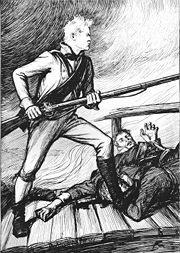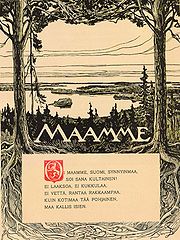
The Tales of Ensign Stål
Encyclopedia

Swedish language
Swedish is a North Germanic language, spoken by approximately 10 million people, predominantly in Sweden and parts of Finland, especially along its coast and on the Åland islands. It is largely mutually intelligible with Norwegian and Danish...
original title: Fänrik Ståls sägner, Finnish
Finnish language
Finnish is the language spoken by the majority of the population in Finland Primarily for use by restaurant menus and by ethnic Finns outside Finland. It is one of the two official languages of Finland and an official minority language in Sweden. In Sweden, both standard Finnish and Meänkieli, a...
: Vänrikki Stoolin tarinat, or year 2007 translation Vänrikki Stålin tarinat) is an epic poem written in Swedish by the Finland-Swedish
Finland-Swedish
Finland Swedish is a general term for the closely related cluster of dialects of Swedish spoken in Finland by Swedish-speaking Finns as their mother tongue...
author Johan Ludvig Runeberg
Johan Ludvig Runeberg
Johan Ludvig Runeberg was a Finnish poet, and is the national poet of Finland. He wrote in the Swedish language....
, the national poet of Finland
Finland
Finland , officially the Republic of Finland, is a Nordic country situated in the Fennoscandian region of Northern Europe. It is bordered by Sweden in the west, Norway in the north and Russia in the east, while Estonia lies to its south across the Gulf of Finland.Around 5.4 million people reside...
. The poem describes the events of the Finnish War
Finnish War
The Finnish War was fought between Sweden and the Russian Empire from February 1808 to September 1809. As a result of the war, the eastern third of Sweden was established as the autonomous Grand Duchy of Finland within the Russian Empire...
(1808–1809) in which Sweden lost its eastern territories; these would become incorporated into the Russian Empire
Russian Empire
The Russian Empire was a state that existed from 1721 until the Russian Revolution of 1917. It was the successor to the Tsardom of Russia and the predecessor of the Soviet Union...
as the Grand Duchy of Finland
Grand Duchy of Finland
The Grand Duchy of Finland was the predecessor state of modern Finland. It existed 1809–1917 as part of the Russian Empire and was ruled by the Russian czar as Grand Prince.- History :...
.
The first part of Ensign Stål was first published in the revolutionary year 1848
Revolutions of 1848
The European Revolutions of 1848, known in some countries as the Spring of Nations, Springtime of the Peoples or the Year of Revolution, were a series of political upheavals throughout Europe in 1848. It was the first Europe-wide collapse of traditional authority, but within a year reactionary...
, the second in 1860. It shaped Finnish identity and was later given out for free during the Winter War
Winter War
The Winter War was a military conflict between the Soviet Union and Finland. It began with a Soviet offensive on 30 November 1939 – three months after the start of World War II and the Soviet invasion of Poland – and ended on 13 March 1940 with the Moscow Peace Treaty...
to raise patriotic spirit. The first chapter of the poem also became the national anthem of Finland
Maamme
Maamme or Vårt land is the title of Finland's national anthem. There is no law on an official national anthem in Finland, but Maamme is firmly established by convention....
.
The name of the title character, "Stål", is Swedish for steel, a typical example of a so-called "soldier's name". These were names, often consisting of simple words for traits or traits related to the military or nature, given to Swedish soldiers by their commanders, and many of Runeberg's characters have them: Dufva, Svärd and Hurtig ('pigeon, 'sword' and 'quick') are other examples.

Wilhelm Mauritz Klingspor
Wilhelm Mauritz Klingspor was a Swedish noble military officer and one of the Lords of the Realm. He is probably best known from his time as field marshal during the Finnish War and for participating in the coup that dethroned Gustav IV of Sweden....
and Johan August Sandels
Johan August Sandels
Count Johan August Sandels was a Swedish soldier and politician, being appointed Governor of Norway 1818 and Field Marshal in 1824...
, generals Carl Nathanael af Klercker, Carl Johan Adlercreutz
Carl Johan Adlercreutz
Carl Johan Adlercreutz was a Swedish and Finnish general of Finland Swedish birth, the chief promoter of the revolution of 1809. He told king Gustav IV to his face that Gustav ought to retire....
, and Georg Carl von Döbeln
Georg Carl von Döbeln
Georg Carl von Döbeln was a Swedish friherre , Lieutenant General and war hero.-Early life:Georg Carl was born at the Stora Torpa manor in Segerstads parish in Västergötland to Johan Jakob von Döbeln and Anna Maria Lindgren...
, and Colonel Otto von Fieandt
Otto von Fieandt
Henrik Otto von Fieandt was a Swedish Colonel who fought in the 1788–90 war with Russia. He appears in Johan Ludvig Runeberg's epic poem The Tales of Ensign Stål as an eccentric but valorous commander.-Life:...
.
Among the most famous characters is the simple but heroic rotesoldat
Swedish allotment system
The allotment system was a system used in Sweden for keeping a trained army at all times. This system came into use in around 1640, and was replaced in the early 1900s by the Swedish Armed Forces conscription system...
Sven Dufva. The organisations Lotta Svärd
Lotta Svärd
Lotta Svärd was a Finnish voluntary auxiliary paramilitary organisation for women. During the Finnish Civil War it was associated with the Suojeluskunta. After the war Lotta Svärd was founded as a separate organisation on September 9, 1920. The name comes from a poem by Johan Ludvig Runeberg...
and Lottorna were named after the character in the poem of the same name
Lotta Svärd (poem)
Lotta Svärd is the fourth poem in the second part of Johan Ludvig Runeberg's epic poem The Tales of Ensign Stål from 1860.The Lotta Svärd poem is about a woman who manned a field kitchen during the Finnish War...
.
From its publication to the mid-twentieth century, The Tales of Ensign Stål was staple reading in both Finnish and Swedish schools. It shaped the later image of the war and of some of its real-life protagonists. Admiral Carl Olof Cronstedt
Carl Olof Cronstedt
Carl-Olof Cronstedt the elder was a Swedish naval commander responsible for the overwhelming Swedish victory at the Second Battle of Svensksund, one of the largest naval battles in history...
is mainly remembered today for his treacherous surrender of the fortress of Sveaborg
Suomenlinna
Suomenlinna, until 1918 Viapori , or Sveaborg , is an inhabited sea fortress built on six islands , and which now forms part of the city of Helsinki, the capital of Finland.Suomenlinna is a UNESCO World Heritage site and popular with both tourists and locals, who...
. The Russian general Yakov Kulnev
Yakov Kulnev
Yakov Petrovich Kulnev was, along with Pyotr Bagration and Aleksey Yermolov, one of the most popular Russian military leaders at the time of the Napoleonic Wars...
, on the other hand, is described positively as a chivalrous and brave soldier and ladies' man.
Ensign Stål was translated into Finnish by a group led by fennoman
Fennoman
The Fennomans were the most important political movement in the 19th century Grand Principality of Finland. They succeeded the fennophile interests of the 18th and early 19th century.-History:...
professor Julius Krohn
Julius Krohn
Julius Leopold Fredrik Krohn was a Finnish folk poetry researcher, a professor of Finnish literature, a poet, a hymn writer, a translator and a journalist. He was born in Viipuri. Krohn worked as a lecturer on Finnish language in Helsinki University from the year 1875 and as a supernumerary ...
in 1867. Later translations were made by Paavo Cajander
Paavo Cajander
Paavo Cajander was a Finnish poet and translator.Cajander was born in Hämeenlinna. He was renowned by translation into Finnish of Shakespeare's works and of Johan Ludvig Runeberg's The Tales of Ensign Stål, whose first verse is currently the Finnish national anthem. He died in...
in 1889 and Otto Manninen
Otto Manninen
Otto Manninen was a Finnish writer, poet, and a celebrated translator of world classics into Finnish language. Along with Eino Leino in the early 20th century, he is considered as a pioneer of Finnish poetry...
1909. Albert Edelfelt
Albert Edelfelt
Albert Gustaf Aristides Edelfelt was a Swedish-speaking Finnish painter.Albert Edelfelt was born in Porvoo, Finland. His father Carl Albert was an architect. Edelfelt admired the poet Johan Ludvig Runeberg, who was a friend of the family...
drew the illustrations between 1894–1900. Due to the dated language, a new translation was issued in 2007. It raised some controversy, in particular due to the new wording of the poem Maamme
Maamme
Maamme or Vårt land is the title of Finland's national anthem. There is no law on an official national anthem in Finland, but Maamme is firmly established by convention....
, the national anthem
National anthem
A national anthem is a generally patriotic musical composition that evokes and eulogizes the history, traditions and struggles of its people, recognized either by a nation's government as the official national song, or by convention through use by the people.- History :Anthems rose to prominence...
of Finland.
External links
- Original Swedish text of the book, at Project RunebergProject RunebergProject Runeberg is an initiative patterned after Project Gutenberg that publishes freely available electronic versions of books significant to the culture and history of the Nordic countries...
.

